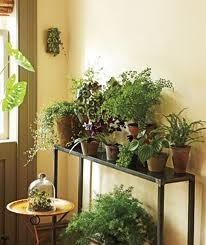 Many gardeners have the same questions about caring for indoor plants. Why do the tips of the leaves turn brown? What’s the right amount of water? Why doesn’t my plant bloom? What’s that stuff on top of the soil, or crusted around the pot? Can I grow succulents indoors?
Many gardeners have the same questions about caring for indoor plants. Why do the tips of the leaves turn brown? What’s the right amount of water? Why doesn’t my plant bloom? What’s that stuff on top of the soil, or crusted around the pot? Can I grow succulents indoors?
Indoor gardeners face many of the same issues as outdoor gardeners. They must choose their houseplants wisely and understand each plant’s requirements for light, water, temperature, humidity, soil and fertilizer. What’s more, indoor gardeners have to be actively involved in plant care.
Palms and spider plants, for example, benefit from bright light and even some direct sun. Succulents and cacti require fast-draining soil and infrequent watering, while the umbrella plant needs frequent watering to thrive indoors. Orchids placed in the sun will scorch. African violets prefer filtered light and even some fluorescent light in winter. The active indoor gardener takes time to learn about each plant’s ideal growing conditions.
The staff at local nurseries should be able to advise you about the houseplants you select. You may also want to purchase a comprehensive indoor-gardening guide to read more about the plants in your care. The University of California’s California Garden Web site (http://cagardenweb.ucanr.edu/houseplants/) can answer many questions.
Houseplants need light to manufacture their food through photosynthesis. Most foliage houseplants are evergreen and native to tropical or subtropical climates. In their natural habitat, they typically live under a canopy of taller vegetation, receiving plenty of indirect bright light but no full sun. In our homes, however, walls and roofs diminish the amount of light and create dark corners with little bright light.
In addition, the angle of light changes seasonally. Some areas of your home may experience direct light in winter, while summer’s sun is too high to enter the room. The amount of light in a room can vary dramatically. Take time to study the available light in your home and notice how it changes over time. Light duration, intensity and quality all have an impact on indoor plants.
As for water, plants need it for many chemical processes. They take it up by their roots and distribute it via a network of water-conducting tissues. Alas, water—too little or too much—contributes to many plant problems. The houseplant novice has the same question as the outdoor gardener: How often should I water my plants?
Two key rules govern houseplant watering: Never permit the soil to dry out completely, and never allow plants to stand in water for an extended time. Roots may die in either situation. As a general rule, a plant in a pot six inches or less in diameter needs water when the top inch of soil is dry. For plants in larger pots, wait to water until the top two inches are dry. Use your index finger to check for moisture. If the soil feels damp, do not water.
Ordinary tap water is usually fine for indoor plants. However, if your water is artificially softened, do not use it on houseplants.
Brown leaf tips may be an indication of inconsistent watering. Use a calendar or other reminder to track your watering schedule. Cacti and succulents do not need water as frequently as umbrella plants. Watering every houseplant every Saturday earns you points for consistency but may not be a good practice.
Providing a comfortable temperature is also essential to your houseplants’ health. Most indoor plants tolerate normal indoor temperature fluctuations. Foliage plants grow best between 70°F and 80°F during the day and between 60°F and 68°F at night. Indoor flowering plants, such as bulbs, miniature cyclamen, African violet and primrose, prefer the same daytime temperatures as foliage plants but lower nighttime temperatures, 55°F to 60°F. These lower evening temperatures promote recovery from moisture loss, intensify flower color and prolong flower life.
Avoid exposing houseplants to wide temperature fluctuations or to extremely high or low temperatures. These conditions may cause plant decline, evidenced by a spindly appearance, damaged foliage or flower drop. Be an active indoor gardener and move plants from windowsills and doorways when the temperature spikes or plummets.
In future columns, we’ll explore other houseplant requirements—for humidity and ventilation, fertilizer, soil, repotting, propagation and pest control. In the meantime, bring your houseplant questions or concerns to the Napa County Master Gardener help desk (address and hours below), or e-mail us your questions using the diagnosis form on our website.
Napa County Master Gardeners welcome the public to visit their demonstration garden at Connolly Ranch on Thursday mornings, from 10:30 a.m. until noon, except the last Thursday of the month. Connolly Ranch is at 3141 Browns Valley Road at Thompson Avenue in Napa. Enter on Thompson Avenue.
Master Gardeners are volunteers who help the University of California reach the gardening public with home gardening information. Napa County Master Gardeners ( http://ucanr.org/ucmgnapa/) are available to answer gardening questions in person or by phone, Monday, Wednesday and Friday, 9 a.m. to Noon, at the U. C. Cooperative Extension office, 1710 Soscol Avenue, Suite 4, Napa, 707-253-4143, or from outside City of Napa toll-free at 877-279-3065. Or e-mail your garden questions by following the guidelines on our web site. Click on Napa, then on Have Garden Questions? Find us on Facebook under UC Master Gardeners of Napa County.